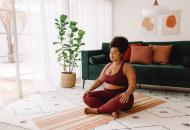Whether you go to the gym regularly or just want to get more active, yoga is a great place to start. More than 30 million Americans practice yoga, and there’s a good reason for it. Yoga, which combines movement, breathing, and mindfulness, can improve your strength, balance, and flexibility, help you manage back pain, and ease anxiety. And that’s just for starters.
But finding the right class — one that fits your personality, physical needs, fitness level, and schedule — can be challenging. If you end up practicing a style of yoga that’s uncomfortable or painful, you may give up on it altogether or, worse, injure yourself.
Before you step into a studio or take a virtual course at home, reflect on your goals and intentions for going to yoga, suggests Kat Heagberg. She’s a yoga teacher and online coach. Also consider what other activities you like or don’t like.
“If someone tells me they have trouble sitting still, I probably won’t recommend a restorative yoga class right away,” Heagberg says.
The good news is that yoga has something for everyone. “There are so many styles and methods to choose from that wherever you are in life and whatever your goals are, you can find a practice that meets you where you are,” adds Heagberg.
Below, find your guide for getting started with yoga or switching gears if your doctor suggests yoga for a specific reason.
Another way to find calm is by talking to a mental health professional. Explore Mind Your HealthTM for access to virtual mental health services.
Style #1: Vinyasa, Ashtanga, hot yoga
Yoga is a mind-body practice that originated in India thousands of years ago. In America, the physical aspects of the practice are often emphasized, which makes it easy to find fitness-based classes. A vigorous class can feel like a workout as you move quickly from one challenging yoga pose to the next. Look for the following three styles:
- Vinyasa, a style of yoga that has you connect movement with breath as you flow through sequences of poses.
- Ashtanga, which emerged from vinyasa. It may feel a little less fluid and often includes highly advanced poses.
- Hot yoga, a style that’s often vinyasa-like but is taught in rooms heated up to 105 degrees Fahrenheit.
Level of experience: Because of pacing, these three styles of yoga classes are best for intermediate to advanced students, unless the class schedule says they’re specifically for beginners. You may want to avoid these styles if you have wrist issues, says Heagberg, because many of the poses invite you to shift your weight into your hands and arms. Avoid hot yoga, or check with your healthcare provider first.
Style #2: Iyengar and yin yoga
Any yoga class that asks you to do standing poses can help you build strength and balance as you activate muscles and experiment with shifting your weight from left to right and onto one leg. The longer the teacher asks you to hold the pose, the better.
On the other hand, seated yoga poses often focus more on stretching. A vinyasa or hot yoga class may help you with strength, balance, and flexibility. But if you need a slower pace and more support, alignment-focused classes, such as Iyengar yoga, may be a better fit.
- Iyengar yoga was developed as a therapeutic form of the practice to help people find more ease in their bodies and minds.
- Yin yoga may also help with flexibility. With this form, you hold seated and supine poses for long, sometimes uncomfortable, periods of time, which allows you to target fascia and other connective tissues.
Level of experience: Look for classes labeled “accessible,” “slow flow,” and “alignment-based.” Most of these should be beginner- and intermediate-friendly. While slow-moving, many yin classes can be challenging and are for intermediate and advanced students who don’t mind sitting still.
Style #3: Restorative yoga and yoga nidra
The parts of yoga that connect to your breath and mindfulness help relax your nervous system and calm your mind. In turn, they help ease anxiety, boost mood, and improve focus. In a recent study from the Indian Institute of Technology on the mental health benefits of yoga during the pandemic, yoga practitioners had lower rates of depression, anxiety, and stress than non-practitioners.
If stress reduction is your primary goal, consider your personality and fitness level, advises Kim Weeks, a former yoga studio owner and current wellness consultant. Weeks has tracked yoga research for Yoga Alliance, a membership organization for yoga teachers. Ask yourself if you think focusing on your breath while moving quickly will provide a nice release, or if it will cause you even more stress.
Vinyasa classes can fit the bill if you like to stay active, while restorative yoga and yoga nidra are designed to calm your body and mind. In a restorative yoga class, you may practice just five poses in an hour, using things such as blankets and bolsters to feel supported.
On the other hand, with yoga nidra (aka yogic sleep), you rest in a comfortable supine position while a teacher guides you through meditations and visualizations. According to the Cleveland Clinic, a 45-minute yoga nidra session could leave you feeling like you just took a three-hour nap.
Level of experience: First, consider your tolerance for both activity and stillness. Restorative yoga and yoga nidra classes are great for all levels, including beginners.
Style #4: Hatha yoga
Yoga has been studied for its effects on arthritis, low back pain, migraines, fibromyalgia (a condition that causes pain all over your body), and other chronic pain conditions.
Researchers from Colorado State University, Clemson University, Indiana University of Medicine, and the University of Colorado found that eight weeks of two 60-minute hatha yoga classes, which included poses, breathing, and meditation, helped lessen chronic pain in subjects who suffered from a range of conditions such as low-back pain, arthritis, and migraines.
Hatha is a gentle and slow form of yoga that emphasizes listening to your body and its needs. Weeks also recommends looking for a yoga therapist — someone who can work with you one-on-one or in small class settings to manage your specific pain points. You can search for one through the International Association of Yoga Therapists.
Level of experience: Customized and slow classes are good for beginners and those who want to move more mindfully.
Choosing the right yoga style that works for you is key, but finding a teacher who matches your needs and personality is just as important. If you’re doing yoga for specific physical and mental concerns, Weeks suggests working with teachers who have at least 500 hours of training, 10 years of teaching experience, and specialized education in the areas where you need help. You can find a registered yoga teacher with Yoga Alliance’s search tool.
Finding the right mental health provider for you is also important. With Mind Your Health, 1 monthly fee can help you get as much care as you need without copays. Learn more online, or call 1-844-211-7730 for more information.
This advertisement contains information compiled by UnitedHealthcare. UnitedHealthcare does not represent that these are statements of fact. Please consult directly with your primary care physician if you need medical advice.
Sources:
Chopra. January 7, 2020. "Restorative Yoga: The Basics + 5 Poses." Retrieved from https://chopra.com/articles/restorative-yoga-the-basics-5-poses.
Cleveland Clinic. “Considering Yoga? 3 Tips for Find the Right Class for You.” September 12, 2016. Retrieved from https://health.clevelandclinic.org/considering-yoga-3-tips-for-finding-the-right-class-for-you/.
Cleveland Clinic. “What is Yoga Nidra?” September 14, 2020. Retrieved from https://health.clevelandclinic.org/what-is-yoga-nidra/.
Government of India Ministry of External Affairs. "Yoga: Its Origin, History and Development." April 23, 2015. Retrieved from https://www.mea.gov.in/in-focus-article.htm?25096/Yoga+Its+Origin+History+and+Development.
Harvard Medical School. "Yoga for pain relief." April 29, 2015. Retrieved from https://www.health.harvard.edu/alternative-and-complementary-medicine/yoga-for-pain-relief.
Harvard T.H. Chan School of Public Health. "Yoga for Exercise." Retrieved from https://www.hsph.harvard.edu/nutritionsource/yoga/. Accessed February 14, 2022.
International Association of Yoga Therapists. "C-IAYT Certified Yoga Therapists." Retrieved from https://www.iayt.org/search/custom.asp?id=4160. Accessed February 14, 2022.
Mayo Clinic. "What is hot yoga?" Retrieved from https://www.mayoclinic.org/healthy-lifestyle/consumer-health/expert-answers/hot-yoga/faq-20058057. Accessed February 14, 2022.
PLoS ONE. "Yoga an effective strategy for self-management of stress-related problems and wellbeing during COVID19 lockdown: A cross-sectional study." February 10, 2021. Retrieved from https://journals.plos.org/plosone/article?id=10.1371/journal.pone.0245214.
Sage Journals Journal of Evidence-Based Integrative Medicine. "Yoga for People With Chronic Pain in a Community-Based Setting: A Feasibility and Pilot RCT." August 8, 2019. Retrieved from https://journals.sagepub.com/doi/full/10.1177/2515690X19863763.
Yoga Alliance. "Find a Registered Yoga Teacher." Retrieved from https://www.yogaalliance.org/Directory?Type=Teacher. Accessed February 14, 2022.
Compliance code:
UHOYOGACLA1










